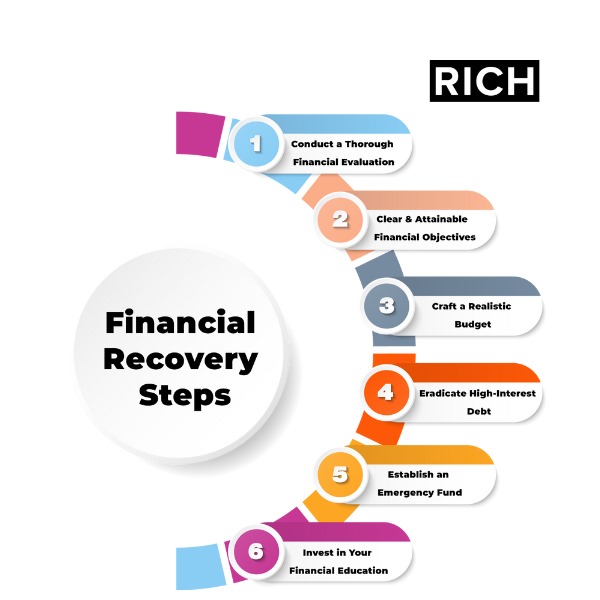
Financial setbacks can occur unexpectedly, affecting individuals from all walks of life. These challenges may arise due to unforeseen medical expenses, job loss, or even past financial decisions. It’s important to understand that no matter the circumstances, you have the power to reset your Financial Life and embark on a journey to financial stability. In this guide, we will explore six essential steps to guide you on the path to financial recovery, with the assistance of Richard Dolan, a seasoned Financial Life Professional who can help you regain control of your financial future.
Conduct a Thorough Financial Evaluation:
To begin the process of resetting your Financial Life, it is crucial to undertake an honest and comprehensive assessment of your current financial status. This entails a meticulous examination of your income, expenditures, outstanding debts, and assets. Craft a detailed budget that delineates your monthly income and all expenses, ranging from necessary items like housing, groceries, utilities, and transportation to discretionary spending.
Identify all your debts, encompassing credit card balances, loans, and any unpaid bills. Catalog your assets, which may include savings accounts, investments, and valuable possessions. This comprehensive overview of your finances will serve as your starting point, giving you insight into the scope of your financial challenges.
Establish Clear and Attainable Financial Objectives:
Once you have a clear understanding of your financial situation, the next step is to set precise and achievable financial goals. These objectives will serve as your guiding star, providing direction and motivation as you work toward resetting your finances. Ensure that your goals adhere to the SMART criteria—Specific, Measurable, Achievable, Relevant, and Time-bound.
For example, if your aim is to eliminate credit card debt, a SMART goal might be to pay off $5,000 of credit card debt within the next 12 months. Alternatively, if your goal is to create an emergency fund, you could set a target to save $1,000 within the next six months. Well-defined goals will help you prioritize your financial decisions and maintain focus.
Craft a Realistic Budget:
A meticulously crafted budget serves as your financial roadmap, enabling you to allocate your income effectively, prioritize expenditures, and ensure that you live within your means. Based on your financial assessment and goals, create a budget that allows you to cover essential expenses, repay debt, and save for your future.
It is crucial to remember that your budget should be adaptable and flexible. As your financial situation improves, adjust your budget to allocate more funds to your financial goals, such as saving for retirement or accelerating your mortgage payments. The key is adhering to your budget and making responsible financial choices.
Eradicate High-Interest Debt:
High-interest debt, such as credit card debt, can be a substantial impediment to financial recovery. Exorbitant interest rates can make it challenging to make significant headway in paying off your debts. To reset your financial life, make it a priority to expeditiously eliminate high-interest debts.
Consider employing strategies such as the debt snowball or debt avalanche method to methodically address your debts. The debt snowball approach involves tackling your smallest debts first, while the debt avalanche method focuses on erasing debts with the highest interest rates. Choose the method that best aligns with your financial objectives and preferences.
Establish an Emergency Fund:
One of the most pivotal steps in resetting your financial life is creating an emergency fund. This fund serves as a financial safety net, shielding you from accruing debt when unforeseen expenses arise, such as medical bills or vehicle repairs. Strive to accumulate at least three to six months’ worth of living expenses in your emergency fund.
Initiate this process by allocating a portion of your income each month until you reach your specified target. Consider maintaining this fund in a separate savings account to prevent mingling with your regular spending money. Possessing an emergency fund will grant you peace of mind and financial security.
Invest in Your Financial Education:
Financial knowledge wields substantial influence on your journey to reset your financial life. Invest time in educating yourself about personal finance, budgeting, investments, and financial management. A wealth of resources is available, including books, online courses, podcasts, and expert advisors such as Richard Dolan, who can provide personalized guidance.
Enhancing your understanding of personal finance empowers you to make informed decisions, evade common financial pitfalls, and optimize your financial strategies. It is an investment in yourself that yields enduring dividends over your lifetime.
Conclusion:
Resetting your Financial Life is an achievable endeavor, necessitating patience, discipline, and unwavering determination. By following these six pivotal steps—conducting a thorough financial evaluation, establishing precise financial objectives, crafting a realistic budget, eradicating high-interest debt, creating an emergency fund, and investing in your financial education—you can take charge of your finances and set out on a path toward a more secure and prosperous future.
Bear in mind that financial setbacks can happen to anyone, but they do not define your financial destiny. Armed with the right mindset and a commitment to making prudent financial choices, you possess the capability to reset your financial life and accomplish your financial aspirations. Initiate this journey today, and take the first stride toward a brighter financial future, guided by the expertise of Richard Dolan, your trusted Financial Life Professional.
Visit www.richardolan.com


